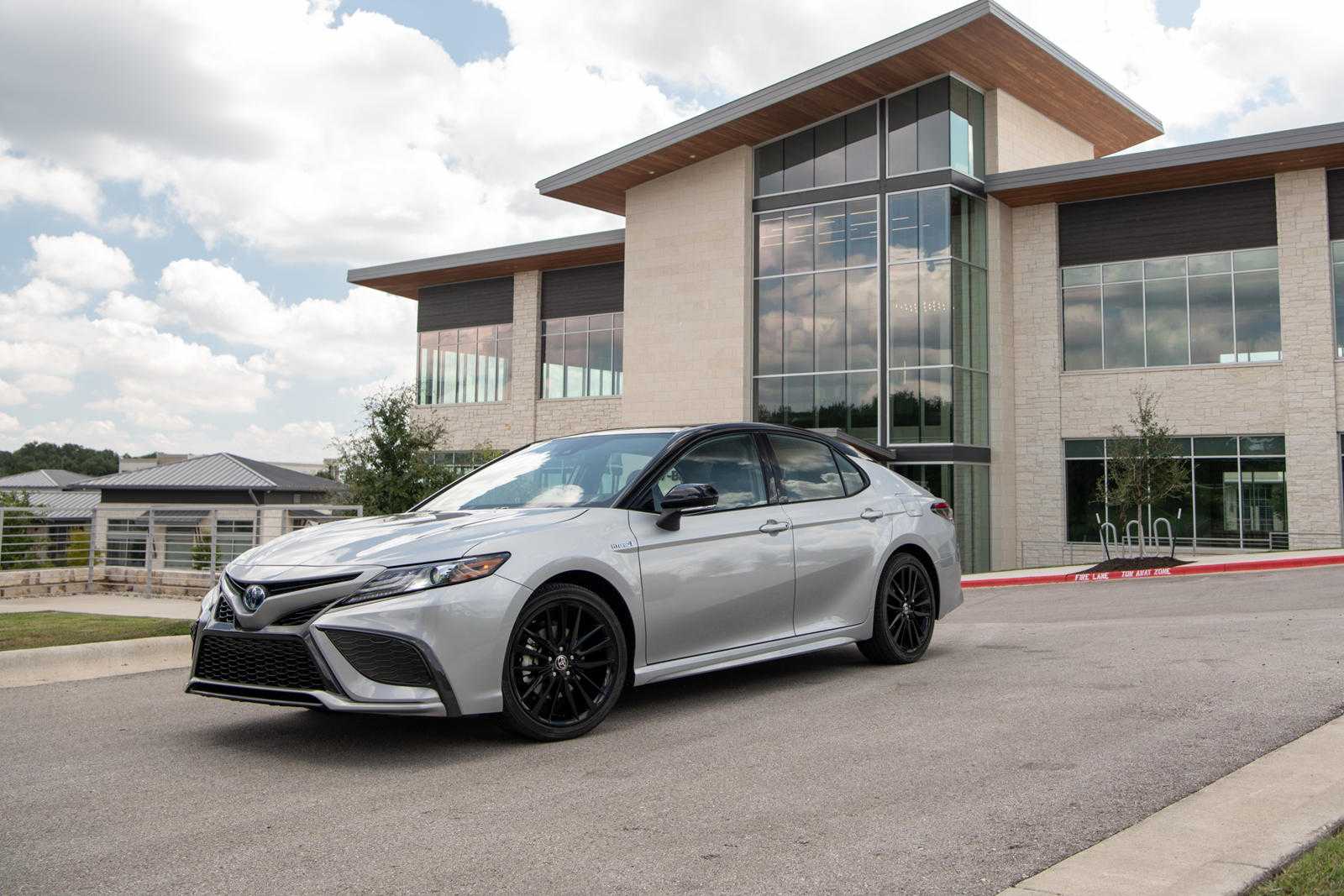Toyota Camry 2023 For Owners
The 2023 Toyota Camry is the epitome of safety and innovation. It comes with a full Supplemental Restraint System (SRS) airbag system that protects everyone inside. In terms of car safety, the SRS airbags are like a complicated web of carefully placed inflatable cushions that are ready to react quickly and accurately if something unexpected happens. These high-tech airbags show that Toyota is always committed to the safety of its passengers. They are meant to lessen the effects of accidents and add an extra layer of defense in case something goes wrong. In this detailed guide, we’ll talk about the 2023 Camry’s SRS airbag system in great detail, including how it works, how it deploys, and how important it is for keeping people safe and reducing injuries in unexpected car accidents.
2023 Toyota Camry Specs, Price, Features and Mileage (Brochure)
Reporting safety defects for U.S. owners
If you believe that your vehicle has a defect that could cause a crash or could cause injury or death, you should immediately inform the National Highway Traffic Safety Administration (NHTSA) in addition to notifying Toyota Motor Sales, U.S.A., Inc. (Toll-free: 1-800- 331-4331). If NHTSA receives similar complaints, it may open an investigation, and if it finds that a safety defect exists in a group of vehicles, it may order a recall and remedy campaign. However, NHTSA cannot become involved in individual problems between you, your dealer, or Toyota Motor Sales, U.S.A., Inc. To contact NHTSA, you may call the Vehicle Safety Hotline toll-free at 1-888-327-4236 (TTY: 1-800-424-9153); go to http://www.safercar.gov; or write to Administrator, NHTSA, 1200 New Jersey Ave. SE., Washington, DC 20590. You can also obtain other information about motor vehicle safety from http://www.safercar.gov
Reporting safety defects for Canadian owners
Canadian customers who wish to report a safety-related defect to Transport Canada, Defects Investigations and Recalls, may telephone the toll-free hotline 1-800-333-0510, mail Transport Canada – ASFAD, 330 Sparks Street, Ottawa, ON, K1A 0N5, or complete the online form at https://www.tc.gc.ca/recalls
Seat belt instructions for Canadian owners
The following is a French explanation of seat belt instructions extracted from the seat belt section in this manual. See the seat belt section for more detailed seat belt instructions in English.
Correct use of seat belts.
- Unroll the diagonal strap so that it passes snugly over the shoulder, but does not come into contact with the neck or slip off the shoulder.
- Place the abdominal strap as low as possible on the hips.
- Adjust the position of the seatback. Sit with your back straight and sit well in the seat.
- Do not twist the seat belt.
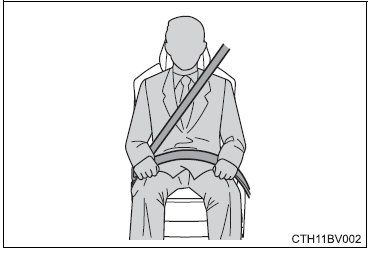
Maintenance and care
Seat belts
Clean with a cloth or sponge dampened with warm soapy water. Regularly check that the belts are not excessively worn, frayed or cut.
Seat belt damage and wear Inspect the seat belt system regularly. Check for cuts, fraying and loose parts. Do not use a damaged seat belt until it has been replaced. A damaged seat belt will not protect an occupant from serious or fatal injury.
SRS Airbag Instructions for Canadian owners
The following is a French explanation of SRS airbag instructions extracted from the SRS airbag section in this manual. See the SRS airbag section for more detailed SRS airbag instructions in English.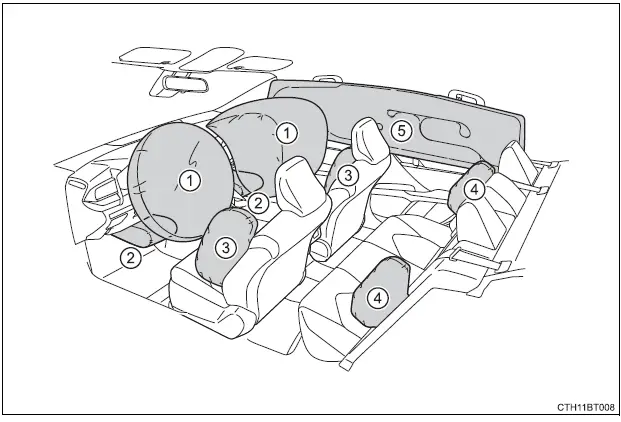
- SRS driver airbag/front passenger airbag Helps protect the head and thorax of the driver and front passenger against impacts against elements in the passenger compartment SRS knee airbags Helps protect the driver and passenger before
- SRS side and curtain airbags SRS front side airbags Help protect the chest of occupants of the front seat SRS rear side airbags Help protect the chest of occupants of the rear side seats SRS curtain airbags
- Mainly help protect the heads of outboard seat occupants
- Can help prevent occupants from being ejected from the vehicle in the event of a rollover
SRS airbag system components
- Front impact sensors
- Rating system passenger seat occupant front (ECU and sensors)
- Airbags knees Side impact sensors (front doors)
- Side impact sensors (before)
- Passenger airbag before
- Side airbags before
- Curtain airbags
- Side airbags back
- AIRBAG ON
- AIRBAG OFF
- indicator lights SRS warning light A
- airbag sensor assembly
- Side impact sensors (rear)
- Driver’s airbag
- Driver’s seat belt buckle switch
- Seat belt pretensioners and limiters force sensor
- Driver’s seat position sensor

Your vehicle is equipped with SMART AIR BAGS designed to US Motor Vehicle Safety Standards (FMVSS208). The airbag sensor assembly (ECU) regulates airbag deployment based on information it receives from sensors, etc., shown above in the system component diagram. This information includes the severity of the impact and the occupancy of the vehicle by the passengers. The rapid deployment of the airbags is achieved by means of a chemical reaction in the pyrotechnic devices, which produces a harmless gas which helps to dampen the movement of the occupants.
WARNINGSRS airbag precautions
- Observe the following precautions regarding the SRS airbags. Failure to follow these precautions could result in serious injury or even death.
- The driver and all passengers in the vehicle must wear their seat belts correctly. SRS airbags are supplemental devices for use with seat belts.
- The SRS driver’s airbag inflates with considerable force, which could cause serious injury or death if the driver is in close proximity to the airbag.
- The US Federal Highway Traffic Safety Authority (NHTSA) advises:
- The driver airbag hazard zone within the first 2 to 3 in. (50 to 75 mm) of deployment, position yourself 10 in. (250 mm) of your driver’s airbag guarantees you a sufficient safety margin.
- This distance is to be measured between the center of the steering wheel and the sternum.
- If you are seated less than 10 in. (250 mm), you can change your driving position in several ways:
- Move your seat as far back as possible, so that you can still comfortably reach the pedals.
- Tilt the seat back slightly. Although the vehicles have different design, a large number of drivers can sit at a distance of 10 in. (250 mm), even with the driver’s seat fully forward, simply by tilting the seat back a little.
- If you have difficulty seeing the road after reclining the back of your seat, use a firm, non-slip cushion to raise yourself up or raise the seat if your vehicle has this feature.
- If your steering wheel is adjustable, tilt it down.
- This has the effect of directing the airbag towards your chest rather than your head and neck.
- Adjust your seat according to the NHTSA recommendations above, while maintaining control of the pedals, steering wheel, and view of the dashboard controls
SRS airbag precautions
- If you attach a seat belt extender to the driver’s seat belt buckle without attaching it to the driver’s seat belt latch, the driver’s SRS frontal airbags determine that the driver has fastened the seat belt correctly. the seat belt is not fastened.
- In this case, the driver’s SRS front airbags may not deploy properly in the event of a collision, which could result in serious injury or death.
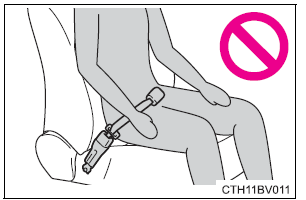
- Be sure to wear the seat belt with the seat belt extender.
- The SRS front passenger air bag also inflates with considerable force, which could cause serious injury or death if the front passenger is very close to the air bag.
- The front passenger seat should be positioned as far away from the air bag as possible by adjusting the seatback so that the front passenger sits upright in the seat.
- Infants and children who are not properly seated and/or restrained can be seriously injured or killed by an inflating air bag.
- An infant or child too small to use a seat belt must be properly restrained in a child safety seat.
- Toyota strongly recommends placing all infants and children in the rear seats of the vehicle and providing suitable restraint systems for them.
- The rear seats are safer for infants and children than the front passenger seat.
- Never install a rear-facing type child safety seat on the front passenger seat, even if the “AIR BAG OFF” indicator light is on.
- In the event of an accident, the force generated by the rapid deployment of the front passenger airbag can seriously injure or even kill the child if the rear-facing child safety seat is installed on the front passenger seat.
SRS airbag precautions
- Do not sit on the edge of the seat or lean against the dashboard.
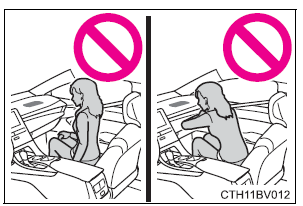
- Do not let a child stand in front of the SRS front passenger airbag or sit on the front passenger’s lap.
- Do not allow front seat occupants to travel with an object on their lap.

- Do not lean against the door, roof side rail or front, side and rear pillars.
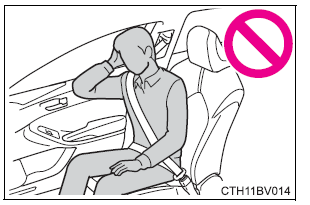
- Do not lean against the door, roof side rail or front, side and rear pillars.
- Do not allow anyone to kneel on the passenger seats leaning against the door or extend their head or hands outside the vehicle.
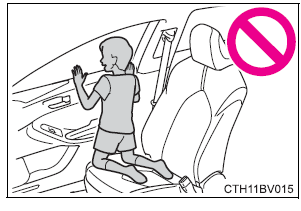
WARNING
SRS airbag precautions
- Do not attach or place anything on places such as the dashboard, steering wheel trim and the lower part of the dashboard.
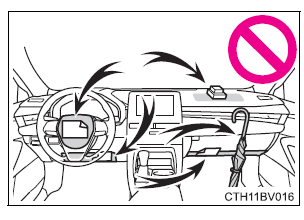
- These items can become projectiles when the SRS driver, front passenger and knee airbags deploy.
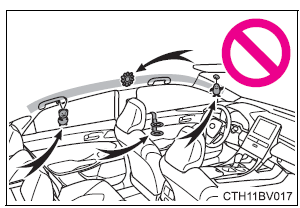
- Vehicles without a hands-free entry and start system: Do not attach heavy, pointed or very hard objects, such as keys and accessories to the keys. These objects could interfere with the deployment of the SRS knee airbag or be thrown toward the driver’s seat by the force of the airbag deployment, constituting a potential hazard.
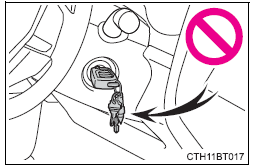
- Do not hang any hangers or hard objects on the clothes hooks. Any of these objects could become projectiles and cause serious injury or death if the SRS curtain airbags inflate.
SRS airbag precautions
- If a vinyl cover is placed over the area where the SRS knee airbag inflates, be sure to remove it.
- Do not use any seat accessory that covers the deployment areas of the SRS side airbags, as they may interfere with the deployment of the SRS airbags. Such accessories could prevent the side air bags from working properly, disable the system or cause the side air bags to inflate accidentally, resulting in death or serious injury.
- Avoid applying excessive pressure or impact to parts containing SRS air bag components or front doors. This could cause the SRS airbags to malfunction.
- Do not touch any components immediately after the SRS airbags deploy (inflate) as they may be hot.
- If you have difficulty breathing after the SRS airbags inflate, open a door or window to bring in fresh air, or get out of the vehicle if it is safe to do so. Wipe off any residue as soon as possible to avoid possible skin irritation.
- If the parts containing the SRS airbags, such as the trim on the steering wheel and the front and rear pillars, are damaged or cracked, have them replaced by your Toyota dealer.
- Do not place anything on the front passenger seat, such as a cushion. This has the effect of distributing the weight of the passenger over the entire surface of the seat, which prevents the sensor from correctly detecting the weight of the passenger. As a result, the front passenger’s SRS frontal airbags may not deploy in the event of a collision.
Modification and disposal of SRS airbag system components
- Do not scrap your vehicle or perform any of the following modifications without consulting your Toyota dealer. The SRS airbags may malfunction or deploy (inflate) accidentally, causing death or serious injury.
- Installation, removal, removal and repair of SRS airbags
- Repairs, modifications, removal or replacement of the steering wheel, dashboard, dashboard, seats or their upholstery, front, side and rear pillars, roof side rails, front door panels, front door trim or front door speakers
- Modifications to the front door panel (for example, drilling a hole in the panel)
- Repairs or modifications to the fenders front, the front bumper or the sides of the passenger compartment
- Installation of a grille guard (bull bar, kangaroo bar, etc.), snow plows, winches, or a luggage rack
- Modifications to the vehicle’s suspension system
- Installation of electronic devices such as mobile radio transmitters/receivers and CD players
- Modifications to your vehicle for a person with a physical disability
- Précautions relatives aux coussins gonflables SRS
FAQ
A: The SRS airbag system is a safety feature designed to protect vehicle occupants in the event of a collision by deploying airbags strategically throughout the vehicle.
A: The 2023 Camry typically comes equipped with multiple airbags, including front airbags, side-impact airbags, and curtain shield airbags.
A: Front airbags deploy in moderate to severe frontal collisions, depending on the impact force.
A: Side-impact airbags deploy in the event of a significant side impact collision.
A: Curtain shield airbags deploy to protect occupants’ heads during side-impact collisions or rollovers.
A: The SRS system is designed to activate in moderate to severe collisions, and not in minor accidents or fender-benders.
A: When a collision is detected, the airbag control unit sends a signal to inflate the airbags with gas within milliseconds, providing a cushion for vehicle occupants.
A: In some models, there may be a switch to deactivate the front passenger airbag to accommodate a child safety seat.
A: While airbags are designed to reduce injury in a collision, improper positioning or sitting too close to the airbag can increase the risk of injury. Always follow safety guidelines and recommendations in the owner’s manual.
A: There is generally no routine maintenance required for the SRS airbag system. However, if the airbag warning light comes on, have it inspected by a qualified technician.
A: If the airbag warning light stays on or flashes, it indicates a potential problem with the SRS system. Have it checked by a professional as soon as possible.
A: No, SRS airbags are designed for one-time use only. After deployment, they must be replaced.
A: The airbag deployment threshold depends on various factors, including the vehicle’s speed and the angle and force of the impact.
A: Always sit upright with your hands on the steering wheel and maintain a safe following distance to reduce the risk of injury from airbag deployment.
A: No, SRS airbags are designed to work in conjunction with seat belts. Seat belts are still the primary means of occupant restraint in a collision.
Useful Link
View Full PDF: 2023 Toyota Camry User Guide
Download Manual: https://www.toyota.com/owners/resources/warranty-owners-manuals
2023 Toyota Camry Specs, Price, Features and Mileage (Brochure)

